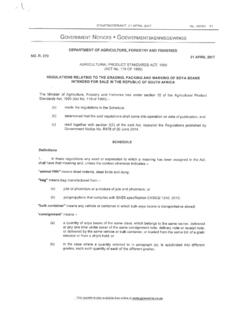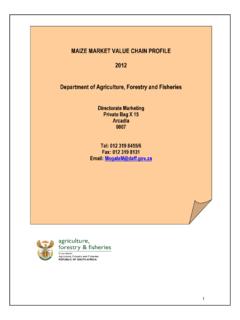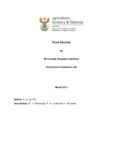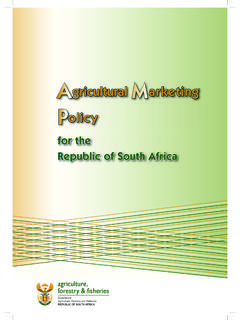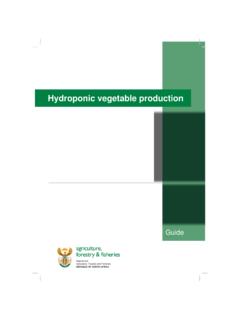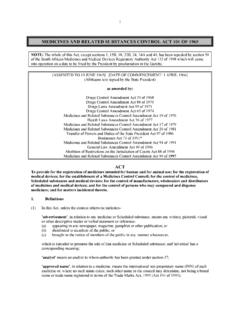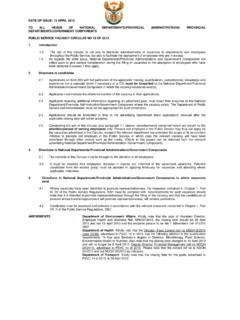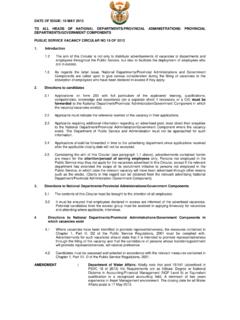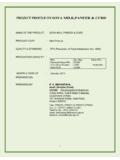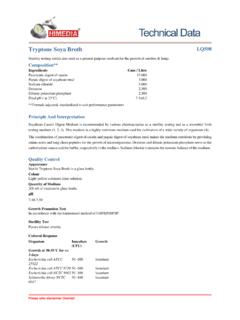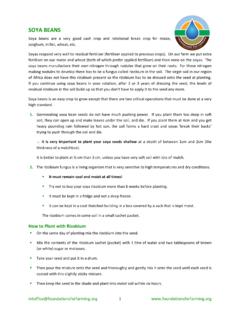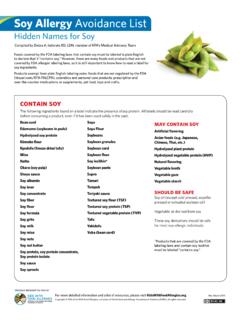Transcription of Production guideline — - nda.agric.za
1 Agriculture,forestry & fisheriesDepartment: Agriculture, Forestry and FisheriesREPUBLIC OF SOUTH AFRICA Production guideline soya beansSoya beans Production guideline 2010 Department of Agriculture, Forestry and Fisheries2010 Printed and published by Department of Agriculture, Forestry and FisheriesCompiled by Directorate Plant Production Private Bag X250 PRETORIA 0001 Tel: +27 12 319 6072 Fax: +27 12 319 6372 E-mail: and layout by Directorate Agricultural Information ServicesObtainable from Resource Centre Directorate Agricultural Information Services Private Bag X144 PRETORIA 0001 CONTENTCONTENTG eneral.
2 1 Cultivation practices .. 6 Post-havest handling .. 16 Production schedule .. 20 Utilisation .. 20 Acknowledgements .. 21 Notes .. 231 GENERAL GENERAL Classifi cationScientific name: Glycine maxCommon name: soya bean, Greater bean Origin and distributionSoya beans are indigenous to Manchuria, China. The crop is considered one of the five oldest cultivated crops and was utilised by the Chinese as a source of food before 2500 BC. However, it was only discovered by the western world as a source of oil and protein in the 19th century. In the past 30 years, world Production of soya beans increased to more than 100 million metric tonnes.
3 Of this, 51% is produced in the USA, 20% in Brazil, 10% in Argentina and 10% in China. The first report of soya beans in South Africa is believed to be in the Cedara Memoirs of to the report, soya bean seeds were imported from China. However, germination was poor, plant developed fast and pods shattered prior to harvesting. soya bean was also grown at the research station at Potchefstroom in the early fifties and a breeding line with good adaptation and resistance to shattering was released under the name Geduld. This was the most important variety up to the early 80s.
4 Initially, soya bean Production was limited to Bapsfontein and the northerly Lowveld areas, but gradually it became important in rotation with wheat in irrigation levels in South AfricaSoya bean Production in South Africa currently ranges from 450 000 to 500 000 tons per annum at an average yield of 2, 5 to 3 t/ha under dry-land conditions. Out of all the provinces, Mpumalanga appears to be the one that produces the largest quantities of soya beans (about 42%). The Free State produces 22% of the total harvest, while KwaZulu-Natal produces 15%, Limpopo 8%, the North West 5% and Gauteng 2%.
5 Major Production areas in South AfricaProvinceDistrictTownsMpumalangaGer t SibandeNkangalaMankaligwaMorgenzon, Volkrust, Piet Retief, PerdekopErmeloSecundaFree StateThabo MofutsanyaneFezile DabiBethlehem, WardenVilliers, VredeKwa-Zulu NatalUmgungundlovuAmajubaZululandUMzinya thieThekwiniGreytownNormandienPongola, VryheidDundeeWinterton, BergvilleLimpopoWaterbergSekhukhuneKoedo eskop, NaboomspruitGroblersdal, Marble HallNorth WestNgaka Modiri MalemaDr. Kenneth KaundaBojanalaMafikeng, Delareyville, Lichtenberg, ZeerustPotchefstroomVentersdorp, KlerksdorpRustenburg, Moretele, Koster, BritsGautengMetswedingSedibengBapsfontei n, BronkorspruitHeidelberg/NigelCultivarsSo ya bean cultivars are area-specific with regard to optional adaptation.
6 The duration from planting to maturity should be approximately 120 to 130 days for a well-adapted cultivar. Where cultivars are planted at higher altitudes or latitudes than recommended; the growth period will be longer. There are several registered determinate and indeterminate cultivars in 3 South Africa with suitability varying according to regions or provinces. The cultivars also vary in their resistance to diseases, stressful weather conditions, weeds and other factors that affect Production . Cultivars with a relatively long growing season should be considered when planting soya bean for fodder where much emphasis should be placed on vegetative growth rather than grain Production .
7 The seeds can be purchased from the registered seed suppliers in the country. In South Africa, more than 80% of the soya bean Production is Roundup Ready cultivars, which can be ob-tained from various registered seed companies. When making a particular cultivar choice, producers should consider characteristics such as growth habit, shattering, pod height, resistance to pest, diseases and chemicals. Conventional cultivarsGMO cultivarsSNK 500 (24)Sonop (150)Stork (254)Maruti (305)Dumela (305)Dundee (254)Jimmy (254)Kiaat (489)Egret (254)Mukwa (489)Mopanie (489)Knap (150)Tambotie (489)LS 678 (484)LS 677 (484)LS 555 (484)PAN 626 (1412)PAN 809 (1412)PAN 660 (1412)PAN 1669 (1412)PAN 538 RR (1412)PAN 1583 R (1412)PAN 1666 R (1412)LS 6164 R (484)LS 6161 R (484)LS 6050 R (484)LS 6162 R (484)AS 4801 R (1076)AG 5601 (80)A 5409 RG (80)Phb 96B01 R (411)Phb 95Y41 R (411)Phb 95Y40 R (411)Phb 95Y20 R (411)Phb 95B53 R (411)
8 Plant descriptionMature plantSoya bean grown for seed Production is an annual, leguminous, warm-temperature, short-day plant, normally bushy and erect (upright growth habit). Usually plant height varies from 40 to 100 cm, plants are much branched with well-developed roots, and each plant produces a number of small pods containing one to four round, usually yellow to black seeds. It has a round hairy stem with branches, and it varies in color according to the cultivar. The plants are categorised into determinate and indeterminate types. The determinate types are of short and terminate growth with the onset of flowering and the growth tips end in a pod-bearing raceme.
9 The harvesting can be done in one round because all pods usually ripen at the same time. The indeterminate types can grow to a height of about 70 cm. They continue to grow vegetatively, they flower and they form pods result-ing in seeds or pods of different sizes that require manual harvesting at different times. 4 RootsThe root system is extensive, with a tap root that may exceed 1, 5 m in length. The tap root has lateral roots within a soil depth of 300 mm. The roots have nodules containing a species specific strain of Rhizobium japonicum bacteria that causes the plant to fix nitrogen to the soil inde-pendently.
10 The lateral root nodules are more important during flowering and seed are alternate, vary in shape, are hairy in some varieties, are nor-mally trifoliate, with the three ovate or lanceolate leaflets borne on a long petiole, and they stipulate. The leaves can appear dark green or tinted with brown, red or blue lesions. Leaves are normally shed as the seed-pods ripen, which is a useful sign for mechanised harvesting. Leaves normally appear yellowish during this time. FlowersFlowers are borne on short racemes originating in leaf axils, with each inflorescence bearing up to twenty small purple or white flowers that usu-ally undergo self pollination.
